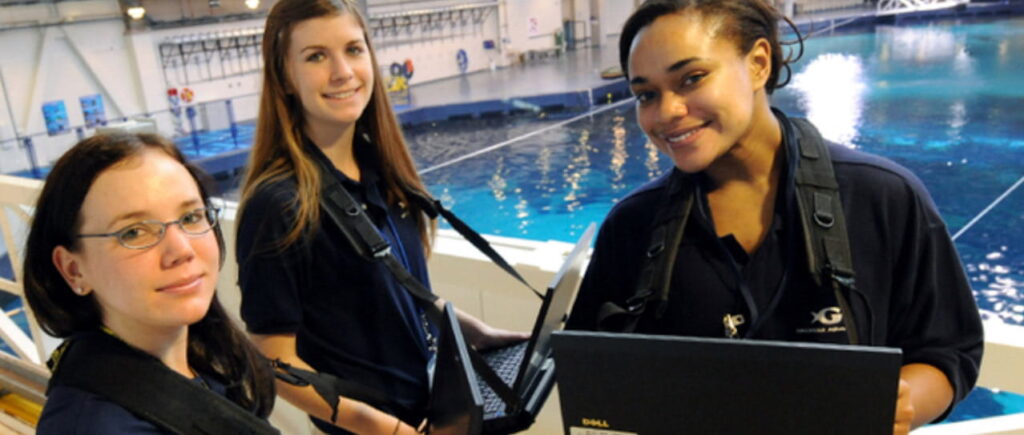
Originally published Feb. 15, 2010 at the Georgia State University website. Archived at the Internet Archive here.
By Jeremy Craig
University Relations
ATLANTA – Faith Perry, Abby Rigdon and Nadine Louw stand on a metal gantry more than four yards off of the ground, overlooking the massive Ocean Voyager exhibit at the Georgia Aquarium.
Swimming about in the more than 6-million-gallon tank are four whale sharks – Alice, Trixie, Yushan and Taroko – moving gracefully among the manta rays and other aquatic life that fascinate visitors below. With laptop computers slung over their shoulders, the GSU students record their movements through the water.
The undergraduate and graduate students are part of an internship program between the university and the aquarium that gives them hands-on experience in studying marine animal behavior, even though Georgia State University is more than 200 miles away from the nearest ocean.
“Our team of biologists is not able to observe animals 24/7, and we have so many other tasks to do, such as diving and giving animal care that are unrelated to observation,” said Chris Coco, a zoological curator at the aquarium. “With the GSU staff, we’ve created a partnership to bring eyes and statistical expertise to generate and interpret data, which will help us to make some educated decisions. Everybody benefits.”
Seven new students enrolled in the program this semester, while two have returned to continue research.
“This is great for students because it gives them experience in hands-on research, and a chance to see what kinds of things they might like to do after graduating, or what kinds of things they want to get involved in while at Georgia State,” said Michael Black, a post-doctoral researcher in the Neuroscience Institute at GSU. “There’s a lot of research in biology and psychology for behavior, and this is a hands-on way to see what it’s like.”
Rigdon, a senior, said she loved the experience. “It’s really interesting seeing everything up top rather than below when you tour the aquarium. It’s breathtaking every time I come here.”
Louw, also a GSU senior, said that the experience is better than what a student would see in a textbook, “and you can get to see how they feed and move around, which makes it more interesting and easier to learn.”
Whale sharks, Rhincodon typus, can get as long as 40 feet in the wild and are listed as a threatened species. They populate tropical seas, and are docile, but continued to be hunted in parts of Asia.
The students record data about the direction of the sharks’ swims, their depth, their closeness to the walls, and other factors. The huge amounts of data that the students collect are helpful to aquarium biologists trying to learn more about the behaviors of the whale sharks, which are the largest species of fish in the world. The Georgia Aquarium’s whale sharks are the only ones exhibited outside of Asia.
Faith Perry, a post-baccalaureate student at GSU, said that she’s looking toward graduate school after the internship program.
“I love being in a marine environment, and right now, this is the closest I can get to it,” she said. “I’ve always been fascinated by fish, especially the deep sea fish.”
Students must take certain prerequisites before entering the program. Students interested in this program should contact Matthew Grober, associate professor of biology, at mgrober@gsu.edu.
Archived at jeremyscraig.com on 12/6/2020